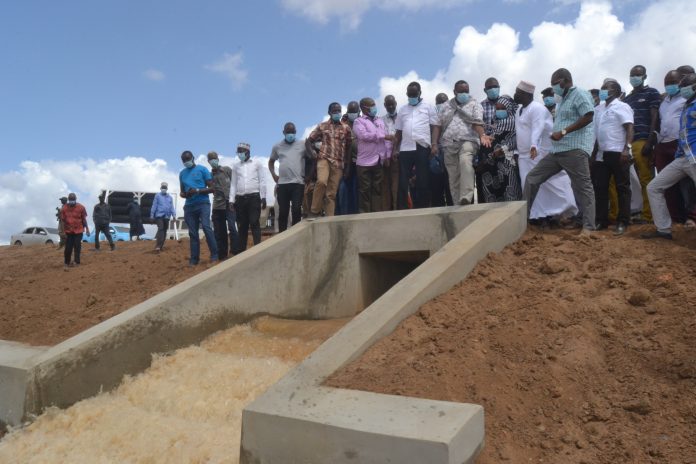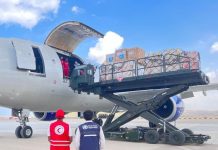The National Irrigation Authority (NIA) is implementing a Sh7.5 billion gravity water flow system projects to replace generators for irrigation in Tana river county. – By Ramadhan Kambi.
The project is being set up at Korakora intake along River Tana in Bura Sub County for Bura Irrigation scheme.
The scheme is currently at an advanced stage.
According to Water and Irrigation Principal Secretary Joseph Irungu, upon completion they will embark on a similar project within the Tana irrigation scheme in Hola so as to move away from water pumping using diesel and electricity which are expensive.
The PS who was on a tour of Tana irrigation scheme said farmers have been paying high costs to get water for irrigating their farms within the two schemes which will soon come to an end.
The NIA own 25,000 acres of land in Bura Irrigation scheme and 16,000 acres within the Tana Irrigation schemes which have not been utilized fully due to the high costs of water.
Mr Irungu said the project of bringing water by gravity was crucial because pumping water to the schemes using generators and electricity is very expensive.
“We are also replacing the old pumps and the money is already with us and we shall also educate the farmers because it is meaningless to bring water when farmers don’t know what to do with it,” he said.
The PS said in Hola the NIA has already completed construction of a Sh. 34 million water reservoir with a capacity of holding 200,000 cubic meters of water which will hold enough water for irrigation.
Billion shilling venture
He said the ongoing projects in Bura will cost Sh. 7.5 billion while those at the Tana Irrigation scheme will cost Sh. 188 million.
The PS further said the government is also spending Sh200 million in Tana Delta on similar water projects.
“I would like to appeal to the county government to help farmers in capacity building, marketing and with farm inputs so that they can benefit from their toil,” he said.
He said the national government has invested in infrastructure but the challenge is managing the same which is the responsibility of the County government can do.
The Manager of Bura Irrigation Scheme Peter Orwa said the high costs of water pumped to farmers are caused by the diesel pumps which are very expensive.
Mr Orwa said currently contractors are already on site adding that phase one and two of the project are going on well.
He said once the project is complete, they will be able to do away with the costly pumping.
Further he said the costs of maintenance of the generator, control panels, the pumps and the cost of supply of water to the Bura irrigation scheme will be lower compared to as it is now.
Currently he said only 12,000 acres of the 25, 000 acres were actively under crops.
Everything On Gravity
The water is normally pumped from the river below into an adjacent wide canal where it flows by gravity 50 kilometers to the scheme but the agency wants to do away with the generators and conduct everything on gravity.
He said, currently farmers pay Sh5,000 for one and a half acre of land per planting season which is a subsidized cost but farmers still struggle to pay.
At the Tana Irrigation Scheme in Hola the manager Peter Kirimi said farmers are charged Sh3,500 per acre of land each planting season.
He also said that the pumping of water is always at a volume of 11 cubic meters of water on a daily basis with only 2,250 acres under use out of the 16,000 acres.
Mr Kirimi said they have 2250 acres under different crops and in every cropping area they have a water storage reservoir.
“We currently have ten reservoirs and the newly constructed one is the largest since it will offer stability in supply of water,” he said
He said the largest reservoir is situated at the tail end of the scheme and it has a holding capacity of 200,000 cubic meters of water.
Mr Kirimi said the new reservoir will be able to satisfy the thirst of farms and also necessitate expansion of farm land by another 1,500 acres to raise the acreage in areas under crops to 4,000 acres by the end of the year.
John Asumbi the chairman of the Tana Irrigation Water Users Committee said that they had crafted a model where farmers who fail to pay for water are either assisted or are barred from the farms in the preceding planting season.
















